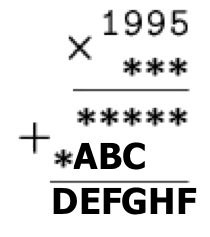Problems
The cells of a \(15 \times 15\) square table are painted red, blue and green. Prove that there are two lines which at least have the same number of cells of one colour.
What is the maximum number of kings, that cannot capture each other, which can be placed on a chessboard of size \(8 \times 8\) cells?
There is a 12 litre barrel filled with water, and two empty barrels (one is 5 litres in volume and the other is 8 litres). Using these barrels, try to
a) divide the water into 2 parts with volumes: 3 litres and 9 litres;
b) divide the water into 2 parts with equal volume.
Michael thinks of a number no less than \(1\) and no greater than \(1000\). Victoria is only allowed to ask questions to which Michael can answer “yes” or “no” (Michael always tells the truth). Can Victoria figure out which number Michael thought of by asking \(10\) questions?
In any group of 10 children, out of a total of 60 pupils, there will be three who are in the same class. Will it always be the case that amongst the 60 pupils there will be: 1) 15 classmates? 2) 16 classmates?
One term a school ran 20 sessions of an after-school Astronomy Club. Exactly five pupils attended each session and no two students encountered one another over all of the sessions more than once. Prove that no fewer than 20 pupils attended the Astronomy Club at some point during the term.
In the rebus below, replace the letters with numbers such that the same numbers are represented with the same letter. The asterisks can be replaced with any numbers such that the equations hold.

An explanation of the notation used: the unknown numbers in the third and fourth rows are the results of multiplying 1995 by each digit of the number in the second row, respectively. These third and fourth rows are added together to get the total result of the multiplication \(1995 \times ***\), which is the number in the fifth row. This is an example of a “long multiplication table”.
In Mexico, environmentalists have succeeded in enacting a law whereby every car should not be driven at least one day a week (the owner informs the police about their car registration number and the day of the week when this car will not be driven). In a certain family, all adults want to travel daily (each for their own business!). How many cars (at least) should the family have, if the family has a) 5 adults? b) 8 adults?
Jessica, Nicole and Alex received 6 coins between them: 3 gold coins and 3 silver coins. Each of them received 2 coins. Jessica doesn’t know which coins the others received but only which coins she has. Think of a question which Jessica can answer with either “yes”, “no” or “I don’t know” such that from the answer you can know which coins Jessica has.
There are \(n\) integers. Prove that among them either there are several numbers whose sum is divisible by \(n\) or there is one number divisible by \(n\) itself.